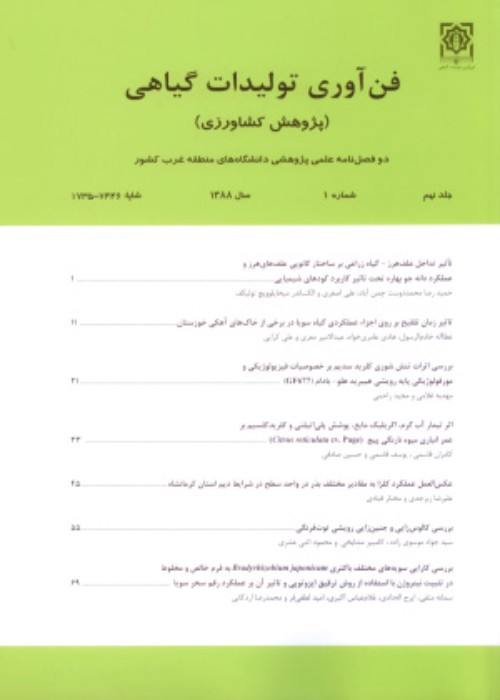Modeling of Sunn Pest Damage (Eurygaster integriceps Put.) on Winter Wheat (Triticum aestivum) Growth and Yield Under Climate Change Condition
Author(s):
Abstract:
The future climate change will alter crop-pest interactions and will affect on amount of crops production, therefore, it is essential to predict pest damage in future conditions. Crop growth models are a technique that researchers could use to study possible impacts of climate change on crops. Although several dynamic models have been developed in recent years, most of them are not generally evaluating impacts of climate change on crop-pest interactions. In the present study, an eco-physiological crop model has been developed to meet these objectives. Its general structure relating to basic crop growth and yield is largely based on LINTUL model, and is written in Fortran Simulation Translator (FST) environment. In this modeling, first, we added phonological development stage (DVS) to LINTUL for simulation of winter wheat growth and then the model calibrated for potential production level. Finally, we incorporate effects of sunn pest damages to winter wheat growth and yield. Parameter values were derived from the literature. The model validated against observed values of DVS, total dry weight yield (TDWY) and grain yield (GY) of winter wheat and winter wheat yield loss due to sunn pest taken from a field experiment. Results indicated that the model was able to explain successfully the observed differences in DVS, TDWY and GY. The loss in TDWY and GY due to sunn pest was also explained satisfactorily. Our simulation results showed that life cycle of winter wheat (from 240 to 217) will be shortened due to accelerate development rate under future climate. The impact of rising temperature on average GY of winter wheat in sunn pest densities was negative (about 47%) while the impact of elevated [CO2] was positive (about 36%) on it. Interaction of elevated [CO2] and temperature also had a negative effect (about 18%) on average GY of winter wheat in sunn pest densities. The impact of rising temperature was positive on sunn pest while the impact of elevated [CO2] had not any effects on it. Therefore, it seems that sunn pest damage on winter wheat growth and yield will be increased (about 7%) in the future climate compared to current climate.
Keywords:
Language:
Persian
Published:
نشریه فنآوری تولیدات گیاهی, Volume:14 Issue: 2, 2015
Pages:
61 to 75
https://magiran.com/p1438324
دانلود و مطالعه متن این مقاله با یکی از روشهای زیر امکان پذیر است:
اشتراک شخصی
با عضویت و پرداخت آنلاین حق اشتراک یکساله به مبلغ 1,390,000ريال میتوانید 70 عنوان مطلب دانلود کنید!
اشتراک سازمانی
به کتابخانه دانشگاه یا محل کار خود پیشنهاد کنید تا اشتراک سازمانی این پایگاه را برای دسترسی نامحدود همه کاربران به متن مطالب تهیه نمایند!
توجه!
- حق عضویت دریافتی صرف حمایت از نشریات عضو و نگهداری، تکمیل و توسعه مگیران میشود.
- پرداخت حق اشتراک و دانلود مقالات اجازه بازنشر آن در سایر رسانههای چاپی و دیجیتال را به کاربر نمیدهد.
In order to view content subscription is required
Personal subscription
Subscribe magiran.com for 70 € euros via PayPal and download 70 articles during a year.
Organization subscription
Please contact us to subscribe your university or library for unlimited access!



